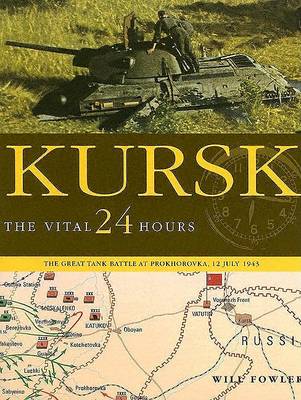24 Hours
3 total works
In any military operation throughout history, few 24-hour periods have been as crucial as that of 6 June 1944. Nearly 7000 ships landed over 132,000 US, British and Canadian troops on the beaches of Normandy in the biggest amphibious landing ever attempted. During that first day, the Allied forces were at their most vulnerable to German counterattack, as Field Marshal Rommel had realised. Had the Germans mounted a significant attack and the landings failed as a result, the course of the war in Europe would have been significantly altered.
With the aid of specially commissioned maps, D-Day: The First 24 Hours describes the
dramatic history of the first 24 hours of the Normandy landings and explains in detail the events that occurred in each landing zone. The book begins with an overview of the immense preparations for the landings and the location of German forces around Normandy. The Allies, able to read the secret German Enigma codes and thus discover the Germans' dispositions, were desperate to persuade the Germans that the landing would be in the Pas de Calais area north east of Normandy, and the various Allied deception plans are described.
D-Day: The First 24 Hours then gives a dedicated chapter to the airborne and glider landings that preceded the main assault, before describing each of the individual beach landings in turn, from west to east. Five beaches were the battlefields for the beginning of the liberation of Europe - codenamed Utah and Omaha for the US beaches, and Gold, Juno and Sword for the British and Canadian. Each landing operation is fully detailed, including the slaughter of US troops at Omaha beach, the chaotic scattering of airborne forces throughout the French countryside, the logistical nightmare of consolidating each bridgehead, the British and Canadian failure to push into Caen, and smaller actions such as the US Rangers scaling the cliffs at Pointe du Hoc to clear German gun batteries.
With the aid of specially commissioned maps, D-Day: The First 24 Hours describes the
dramatic history of the first 24 hours of the Normandy landings and explains in detail the events that occurred in each landing zone. The book begins with an overview of the immense preparations for the landings and the location of German forces around Normandy. The Allies, able to read the secret German Enigma codes and thus discover the Germans' dispositions, were desperate to persuade the Germans that the landing would be in the Pas de Calais area north east of Normandy, and the various Allied deception plans are described.
D-Day: The First 24 Hours then gives a dedicated chapter to the airborne and glider landings that preceded the main assault, before describing each of the individual beach landings in turn, from west to east. Five beaches were the battlefields for the beginning of the liberation of Europe - codenamed Utah and Omaha for the US beaches, and Gold, Juno and Sword for the British and Canadian. Each landing operation is fully detailed, including the slaughter of US troops at Omaha beach, the chaotic scattering of airborne forces throughout the French countryside, the logistical nightmare of consolidating each bridgehead, the British and Canadian failure to push into Caen, and smaller actions such as the US Rangers scaling the cliffs at Pointe du Hoc to clear German gun batteries.
In early October 1942 the German Sixth Army realized that it had one last chance to break through the Soviet lines and capture Stalingrad before exhaustion and the Russian winter set in. Stalingrad: The Vital 7 Days looks in detail at this desperate last-gasp attempt by the Germans to win the battle of Stalingrad in an all-out effort, and how the Red Army managed to cling on against the odds, marking the turning point of the war on the Eastern Front.
Beginning with the background to the assault on Stalingrad, the book shows how initially the Germans made good progress against the city's defenders, but failed to break them. By 14 October 1942 the German Sixth Army was ready to make its third, final assault on the Soviet 62nd Army. On that day Hitler issued an order halting all other offensive operations on the Eastern Front -Stalingrad was to be the deciding battle that determined whether the Germans could maintain their position in the East. Victory would give Germany access to the resources of the Caucasus and the Ukraine, including oil, while defeat would demoralize the Wehrmacht before winter set in.
With the aid of specially commissioned maps, Stalingrad: The Vital 7 Days gives a dramatic blow-by-blow account of the desperate struggle to control the left bank of, the Volga and the key strong points in the city: the tractor works and the Red October and Barrikady factories.
With firsthand accounts from both sides, vivid photographs, and specially commissioned maps of the combat zones, Stalingrad: The Vital 7 Days is a comprehensive examination of the decisive failure of the German assault that ultimately decided the course of the war in the East.
Beginning with the background to the assault on Stalingrad, the book shows how initially the Germans made good progress against the city's defenders, but failed to break them. By 14 October 1942 the German Sixth Army was ready to make its third, final assault on the Soviet 62nd Army. On that day Hitler issued an order halting all other offensive operations on the Eastern Front -Stalingrad was to be the deciding battle that determined whether the Germans could maintain their position in the East. Victory would give Germany access to the resources of the Caucasus and the Ukraine, including oil, while defeat would demoralize the Wehrmacht before winter set in.
With the aid of specially commissioned maps, Stalingrad: The Vital 7 Days gives a dramatic blow-by-blow account of the desperate struggle to control the left bank of, the Volga and the key strong points in the city: the tractor works and the Red October and Barrikady factories.
With firsthand accounts from both sides, vivid photographs, and specially commissioned maps of the combat zones, Stalingrad: The Vital 7 Days is a comprehensive examination of the decisive failure of the German assault that ultimately decided the course of the war in the East.
With first-hand accounts from both sides, vivid photographs and specially commissioned maps of the combat zones, this highly illustrated book is a comprehensive examination of the decisive failure of the German's last large-scale offensive on the Eastern Front.


